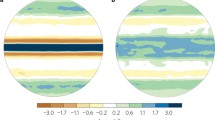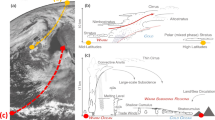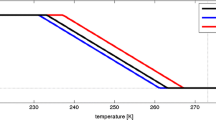Abstract
The increase in the vigor of the hydrological cycle simulated in a 2 × CO2 experiment with the Canadian Climate Centre general circulation model is smaller than that obtained by other models which have similar increases in mean surface temperature. The surface energy budget, which encompasses also the moisture budget for the oceans, is analyzed. Changes in the net radiative input to and sensible heat flux from the surface act to warm it. This is balanced, at the new equilibrium, by a change in the latent heat flux which acts to cool it. Although this same general behavior is seen in other models, the increase in radiative input to the surface in the CCC GCM is smaller than in other models while the change in the sensible heat flux is of similar size. As a consequence, the latent heat flux required for balance is smaller. The comparatively small increase in the net radiative input at the surface occurs because of a decrease in the solar component. On average the decrease in solar input in the tropical region outweighs the higher latitude increase associated with the snow/ice albedo feedback. The notable tropical decrease in solar input occurs because the albedo of the clouds increase enough in this region to outweigh a small decrease in cloud amount. The increase in cloud albedo in the warmer and moister tropical atmosphere is a consequence of the parameterized cloud optical properties in the model which play an important role in the regulation of the surface energy and moisture budgets. The results demonstrate some of the consequences of the negative feedback mechanism associated with increasing cloud albedo in the model. They also suggest that the simulated change in the vigor of the hydrological cycle is not a simple function of the average increase in surface temperature but is a consequence of all of the processes in the model which control the available energy at the surface as a function of latitude.
Similar content being viewed by others
References
Boer GJ, McFarlane NA, Laprise R, Henderson JD, Blanchet J-P (1984a) The Canadian Climate Centre spectral atmospheric general circulation model. Atmos-Ocean 22:397–429
Boer GJ, McFarlane NA, Laprise R (1984b) The climatology of the Canadian Climate Centre general circulation model as obtained from a five-year simulation. Atmos-Ocean 22:430–475
Boer GJ, McFarlane NA, Lazare M (1992) Greenhouse gas induced climate change simulated with the CCC second generation GCM. J Climate 5:1045–1077
Budyko MI (1977) Climate Changes, Amer Geophys Un, 261 pp
Cubasch U, Cess RD (1990) Processes and modelling. In: Climate Change. The IPCC Scientific Assessment, Cambridge University Press, pp 69–92
Gutowski WJ, Gutzler DS, Wang W-C (1991) Surface energy balances of three general circulation models: implications for simulating regional climate change. J Climate 4:121–134
Hansen J, Lacis A, Rind D, Russell G, Stone P, Fung I, Ruedy R, Lerner J (1984) Climate sensitivity: analysis of feedback mechanisms. In: Climate processes and climate sensitivity. Geophys Monogr Ser 29:130–163
McFarlane NA, Boer GJ, Blanchet J-P, Lazare M (1992) The Canadian Climate Centre second generation general circulation model and its equilibrium climate. J Climate 5:1013–1044
Mitchell JFB (1989) The “greenhouse” effect and climate change. Rev Geophys 27:115–139
Mitchell JFB, Senior CA, Ingram WJ (1989) CO2 and climate: a missing feedback? Nature 341:132–134
Mitchell JFB, Manabe S, Tokioka T, Meleshko V (1990) Equilibrium climate change. In: Climate Change. The IPCC Scientific Assessment, Cambridge University Press, pp 131–172
National Academy of Sciences (1975) Understanding Climatic Change, Natl Acad Sci, 239 pp
Ramanathan V (1981) The role of ocean-atmosphere interactions in the CO2 climate problem. J Atmos Sci 38:918–930
Ramanathan B, Collins W (1991) Thermodynamic regulation of ocean warming by cirrus clouds deduced from observations of the 1987 El Niño. Nature 351:27–32
Randall DA, Cess RD, Blanchet J-P, Boer GJ, Dazlich DA, Del Genio AD, Deque M, Dymnikov V, Galin V, Ghan SJ, Lacis AA, Le Treut H, Li Z-X, Liang X-Z, McAvaney BJ, Meleshko VP, Mitchell JFB, Morcrette J-J, Potter GL, Rikus L, Roeckner E, Royer J-F, Schlese U, Sheinin DA, Slingo J, Sokolov AP, Taylor KE, Washington WM, Wetherald RT, Yagai I, Zhang M-H (1992) Intercomparison and interpretation of surface energy fluxes in atmospheric general circulation models. J Geophys Res 97:3711–3724
Ravel A, Ramanathan V (1989) Observational determination of the greenhouse effect. Nature 342:758–761
Schlesinger ME, Zhao Z (1989) Seasonal climate changes induced by doubled CO2 as simulated by the OSU atmospheric GCM/mixed-layer model. J Climate 2:459–495
Schlesinger ME, Mitchell JFB (1987) Climate model simulations of the equilibrium climatic response to increased carbon dioxide. Rev Geophys 25:760–798
Washington WM, Meehl GA (1984) Seasonal cycle experiment on the climate sensitivity due to a doubling of CO2 with an atmospheric general circulation model coupled to a simple mixed-layer ocean model. J Geophys Res 89:9475–9503
Weatherald RT, Manabe S (1986) An investigation of cloud cover change in response to thermal forcing. Clim Change 8:5–24
Wilson CA, Mitchell JFB (1987) A doubled CO2 climate sensitivity experiment with a GCM including a simple ocean. J Geophys Res 92:13315–13343
Author information
Authors and Affiliations
Rights and permissions
About this article
Cite this article
Boer, G.J. Climate change and the regulation of the surface moisture and energy budgets. Climate Dynamics 8, 225–239 (1993). https://doi.org/10.1007/BF00198617
Received:
Accepted:
Issue Date:
DOI: https://doi.org/10.1007/BF00198617




